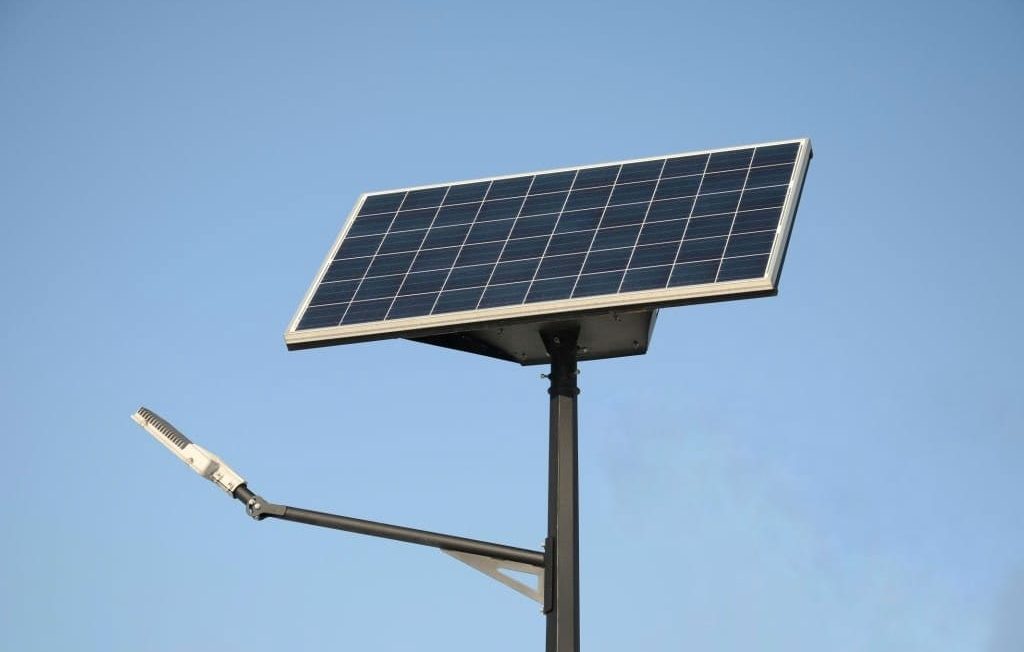Solar Street Light
Home > Services
Services
Contact Info
Discover Worry-Free Solar Solutions for a Sustainable Tomorrow. Achieve Self-Sufficiency and Lower Electricity Bills Today!
+91 9049025511
Info File

Solar street lights are stand-alone lighting systems that use solar energy to illuminate streets, parks, pathways, and other outdoor areas. These lights are eco-friendly, cost-effective, and provide reliable lighting in remote and urban areas alike. They consist of several key components that work together to harness solar power, store it, and use it to power the lights during the night.
Key Components
Solar Panel:
- Function: Captures sunlight and converts it into electrical energy.
- Types: Monocrystalline, polycrystalline, or thin-film solar panels.
- Installation: Mounted on the top of the street light pole to maximize exposure to sunlight.
LED Lamp:
- Function: Provides bright and efficient lighting.
- Types: Light Emitting Diode (LED) lamps are preferred for their high efficiency, long lifespan, and low power consumption.
Rechargeable Battery:
- Function: Stores the electrical energy generated by the solar panel during the day to power the LED lamp at night.
- Types: Common types include lead-acid, lithium-ion, and nickel-metal hydride (NiMH) batteries.
- Capacity: Sized to provide adequate power for the desired lighting duration and to withstand multiple days of cloudy weather.
Charge Controller:
- Function: Regulates the power flow from the solar panel to the battery and from the battery to the LED lamp. It prevents overcharging and deep discharging of the battery.
- Types: Pulse Width Modulation (PWM) and Maximum Power Point Tracking (MPPT) controllers.
Pole and Mounting Structure:
- Function: Supports the solar panel, battery, and LED lamp at a suitable height for effective illumination.
- Materials: Typically made of galvanized steel or aluminum to withstand environmental conditions.
Sensors (Optional):
- Function: Enhances the functionality and efficiency of the solar street light.
- Types:
- Motion Sensors: Detect movement and increase light intensity when someone approaches.
- Light Sensors: Automatically turn the lights on at dusk and off at dawn

How it Works
Solar Energy Collection:
- During the day, the solar panel captures sunlight and converts it into DC electricity.
Energy Storage:
- The generated electricity is stored in the rechargeable battery through the charge controller.
Lighting Control:
- At dusk, the light sensor activates the LED lamp, drawing power from the battery.
- The lamp remains illuminated throughout the night.
Energy Management:
- The charge controller ensures efficient energy use by preventing overcharging during the day and deep discharging at night.
Sensor Activation (if installed):
- Motion sensors can increase light intensity when movement is detected, conserving battery power during low-traffic periods.
Advantages
Energy Efficiency:
- Uses renewable solar energy, reducing electricity bills and dependence on grid power.
- High-efficiency LED lamps consume less power and provide bright illumination.
Environmental Benefits:
- Reduces carbon footprint by utilizing clean solar energy.
- Minimizes light pollution with targeted lighting.
Cost Savings:
- Low operational costs due to the absence of electricity bills.
- Minimal maintenance requirements and long lifespan of components.
Independence from Grid:
- Ideal for remote or off-grid locations where grid electricity is unavailable or unreliable.
- Ensures continuous lighting during power outages.
Easy Installation:
- Requires no trenching for electrical wires, reducing installation costs and time.
- Flexible placement options as each light operates independently.
Types of Solar Street Lights
Standalone Solar Street Lights:
- Features: Independent units with solar panels, batteries, and LED lamps integrated into a single system.
- Applications: Suitable for areas where grid electricity is unavailable or too expensive to install.
All-in-One Solar Street Lights:
- Features: Compact units with integrated solar panels, batteries, and LED lamps in a single fixture.
- Applications: Easy to install and maintain, ideal for residential streets, parks, and pathways.
Grid-Tied Solar Street Lights:
- Features: Connected to the electrical grid but primarily powered by solar energy. Excess energy can be fed back into the grid.
- Applications: Urban areas where grid reliability is essential, but solar energy can offset electricity costs.
Hybrid Solar Street Lights:
- Features: Combines solar power with another energy source (e.g., wind or grid power) to ensure continuous operation.
- Applications: Areas with variable weather conditions or where uninterrupted lighting is critical.
On-grid Solar System
An on-grid solar system, also known as a grid-tied or grid-connected solar system, is a solar power system that is connected to the electrical grid.
Off-grid Solar System
An off-grid solar system, also known as a standalone solar system, is a solar power system that operates independently of the electrical grid.

